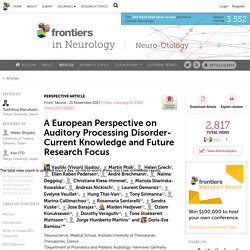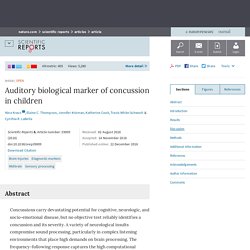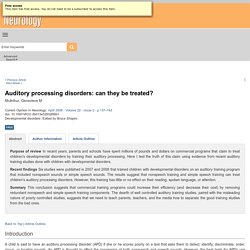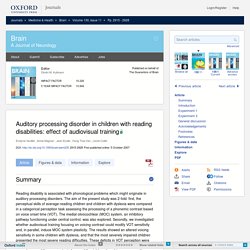

Auditory Processing Disorder (APD) BioMed Central - Auditory Processing Disorder. Frontiers - Auditory Processing Disorder. Informa Healthcare - Auditory Processing Disorder. Ingentaconnect - Auditory Processing Disorder. Nature.com. Plos One - Audiology and Auditory Processing Disorders.
PNAS. PubMed Central - Auditory Processing Disorder. Science Direct - Auditory Processing Disorder. Wiley Online - Auditory Processing Disorder. Wolters Kluwer Health. Abnormal Auditory Cortical Activation in Dyslexia 100 msec after Speech Onset. May 15, 2002, Vol. 14, No. 4, Pages 603-617 Posted Online March 13, 2006.

(doi:10.1162/08989290260045846) © 2002 Massachusetts Institute of Technology Päivi Helenius Helsinki University of Technology Riitta Salmelin Ulla Richardson University College London Seija Leinonen University of Jyväskylä Heikki Lyytinen Reading difficulties are associated with problems in processing and manipulating speech sounds. Kaisa Lohvansuu, Jarmo A. Roozbeh Rezaie, Shalini Narayana, Katherine Schiller, Liliya Birg, James W. Jarmo A. Mark W. Lin Wang, Ole Jensen, Danielle van den Brink, Nienke Weder, Jan-Mathijs Schoffelen, Lilla Magyari, Peter Hagoort, Marcel Bastiaansen. (2012) Beta oscillations relate to the N400m during language comprehension.
Riikka Lovio, Anu Halttunen, Heikki Lyytinen, Risto Näätänen, Teija Kujala. (2012) Reading skill and neural processing accuracy improvement after a 3-hour intervention in preschoolers with difficulties in reading-related skills. Jarmo A. P. K. Richard E. J.A. Anne G.F.M. Aetiology and clinical presentations of auditory processing disorders—a review. Hearing is a complex process that orchestrates transduction of the acoustic stimulus into neural impulses by the ears, transmission of the neural impulses by the auditory nerves to the brain, and perceptual registration and cognitive elaboration of the acoustic signal by the brain as well as conscious perception of the sound.

Hearing impairment(s) arising from pathology of the brain may have detrimental consequences on a child's life if untreated; however, diagnostic and management strategies for these “central” hearing impairments in childhood are rarely implemented. These auditory deficits have been collectively termed “auditory processing disorders”, in order to incorporate in the term the interaction between peripheral and central pathways.1 In terms of pathophysiological mechanisms, APD may be classified as occurring in the presence of2: neurological conditions; delayed central nervous system maturation; or other developmental disorders. Tumours of the CANS. A European Perspective on Auditory Processing Disorder-Current Knowledge and Future Research Focus. Introduction Hearing loss (HL), i.e., reduced pure tone sensitivity affects over 5% of the world’s population (1) and is the fifth leading cause of Years Lived with Disability, a component of the Disability-Adjusted Life Year, used to measure the global burden of disease (2).

This hearing impairment, however, does not include the children and adult individuals who have normal hearing sensitivity but who experience auditory processing difficulties in everyday life that are reflected in reduced performance in other audiometric tests such as speech in noise or complex non-speech sound perception (3). Altered white matter microstructure underlies listening difficulties in children suspected of auditory processing disorders: a DTI study. A locus for an auditory processing deficit and language impairment in an extended pedigree maps to 12p13.31-q14.3. Assessment of cortical auditory evoked potentials in children with specific language impairment. P300 wave record is connected to record of P1, N1, P2, and N2 potentials which occur earlier.

The researchers are not unanimous when referring to the aforementioned latency of potentials in children with SLI. Some researchers indicate that differences in P1, N1, P2, and N2 latency values between children with SLI and the control group are statistically insignificant [17, 18]. Similar results were achieved in this research. The average P1, N1, and P2 latency values do not indicate statistically significant differences between the study group and the control group. On the other hand, the results of research conducted by Korpilathi and Langa, and Tonnquist-Uhlen are disparate [19, 20]. Auditory biological marker of concussion in children : Scientific Reports. We tested the hypothesis that concussions disrupt the neural processing of speech.

Children with a concussion exhibit a signature neural profile that distinguishes them from their non-concussed peers. This profile is manifest in the neural coding of a specific ingredient of sound: following a concussion, neural responses process the F0 of speech less robustly and are smaller, slower, and less accurate. The symptom load of an injury relates to this neural profile—concussed children with the highest symptom loads have the weakest responses to speech. We also show that the FFR reliably identifies which children sustained a concussion, suggesting its clinical potential as a biological marker of an injury. Auditory Language Comprehension in Children with Developmental Dyslexia: Evidence from Event-related Brain Potentials. October 2006, Vol. 18, No. 10, Pages 1676-1695 Posted Online October 2, 2006.

(doi:10.1162/jocn.2006.18.10.1676) © 2006 Massachusetts Institute of Technology B. Sabisch1, 2, A. 1Max Planck Institute for Human Cognitive and Brain Sciences, Leipzig, Germany. Auditory perceptual processing in people with reading and oral language impairments: current issues and recommendations. Auditory processing and the development of language and literacy. Abstract This paper considers evidence for basic auditory processing impairments associated with dyslexia and specific language impairment, against a back-drop of findings from studies of the normal development of auditory and phonological processing.

Auditory Processing Disorder And Brain Pathology In A Preterm Child With Learning Disabilities. Auditory processing disorder: An overview for the clinician. It was not that long ago that the “central auditory test battery” for the average audiologist consisted of presenting a few PB words with some ipsilateral white noise masking tossed in.

Depending on whose article you read, the performance for normals on this test could be anywhere from 35% to 75%, so whatever score the patient obtained was usually okay. Fortunately, a lot has changed since then, and we have many people to thank. One of the first chapters on central auditory testing in an audiology text was by Ettore Bocca, the 1963 edition of Modern Developments in Audiology.
It's still a good read today. I'm guessing that many of you cut your teeth in this area by attending a workshop given by Chuck Berlin or Jack Katz. Since Ettore's chapter, we've learned a lot—not only concerning the diagnosis of auditory processing disorders, but also regarding treatment and intervention strategies. Auditory processing disorders: can they be treated? Introduction A child is said to have an auditory processing disorder (APD) if she or he scores poorly on a test that asks them to detect, identify, discriminate, order, group, or localize sounds.

An APD is thought to affect the processing of both nonspeech and speech sounds. However, the best tests for APDs use nonspeech sounds because nonauditory factors, like language exposure or language expertise, can confound responses to speech sounds [1••]. Can a child's APD be treated? To answer this question, I will first discuss who has an APD, how APD is treated, and how APD treatments should be tested. Auditory processing disorder in children with reading disabilities: effect of audiovisual training. Materials and methods Participants A group of 46 school-aged children served as subjects.

Twenty-three were formally classified as dyslexic on neuropsychological and speech-therapy assessment. Auditory processing disorders in neurological patients and in patients with developmental disorders. In the mid 1950's, Bocca, Calearo and Cassinari (1954) made the seminal observations that patients with temporal lobe tumours complained of hearing difficulties, despite the presence of normal hearing thresholds and normal speech recognition in quiet. Around the same time, Myklebust (1954) proposed that central auditory function ought to be considered and assessed in children with communication disorders. Over the last 20-30 years, it has become increasingly recognised that impaired structure and/or function of the brain may have little or no effect on hearing thresholds, but may cause deficits in other aspects of the hearing process.
These deficits are collectively referred to as an “auditory processing disorder” (APD). Recent progress in auditory neuroscience has only just begun to translate into clinical practice, with the development of more sensitive and specific test batteries for APD, however, at the moment there are no universally accepted diagnostic criteria for APD. Auditory processing disorders: It's not just kids who have them.
1 We're always hearing and reading about auditory processing disorders (APD) in children. Are you suggesting that APD can also occur in adults? It certainly can. As a matter of fact, the first recognized cases of APD were probably adults, even if they weren't labeled that at the time. Auditory Processing Disorder (APD): Progress in Diagnostics So Far. A Mini-Review on Imaging Techniques. Auditory stream biasing in children with reading impairments. Central Auditory Processing Disorder as the Presenting Manifestation of Subtle Brain Pathology.
CaseReport Article Central Auditory Processing Disorder as the Presenting Manifestation of Subtle Brain Pathology: Problemas de procesamiento auditivo central como manifestación inicial de patología cerebral ligera 2000, Vol. 39, No. 3 , Pages 168-172 Doris Eva Bamiou, Alkis Liasis, Stewart Boyd, Mazal Cohen, and Ewa Raglan 1Audiology Department, Great Ormond Street Hospital, London, UK 2Neurophysiology Department, Great Ormond Street Hospital, London, UK 3Academic Division of Audiological Medicine, Royal National Throat Nose Ear Hospital, London, UK †Correspondence: Doris Eva Bamiou, Audiology Department Great Ormond Street Hospital London, WC1N 3JH, UK The objective of this case-report study was to assess the presence of central auditory impairment in a patient with a normal neurological examination. Central auditory processing disorder (CAPD) tests in a school-age hearing screening programme - analysis of 76,429 children. Central auditory processing disorder (CAPD) tests in a school-age hearing screening programme – analysis of 76,429 children.
Ann Agric Environ Med 2015;22(1):90–95 [b]Introduction and objective[/b]. Hearing disorders among school-age children are a current concern. Continuing studies have been performed in Poland since 2008, and on 2 December 2011 the EU Council adopted Conclusions on the Early Detection and Treatment of Communication Disorders in Children, Including the Use of e-Health Tools and innovative Solutions. The discussion now focuses not only on the efficacy of hearing screening programmes in schoolchildren, but what should be its general aim and what tests it should include? This paper makes the case that it is important to include central auditory processing disorder (CAPD) tests. Childhood auditory processing disorder as a developmental disorder: The case for a multi-professional approach to diagnosis and management.
Childhood auditory processing disorder as a developmental disorder: The case for a multi-professional approach to diagnosis and management February 2010, Vol. 49, No. 2 , Pages 83-87 Caroline Witton School of Life and Health Sciences, Aston University, Birmingham, UK Caroline Witton, School of Life and Health Sciences, Aston University, Birmingham, B4 7ET, UK. E-mail: c.witton@aston.ac.uk. Common Misconceptions Regarding Pediatric Auditory Processing Disorder. Hearing acuity may be difficult to assess in children and does not always reflect how a child “hears” in everyday life. The audiological test battery must be built around the pure tone audiogram and may include tympanometry, stapedial reflexes, auditory brainstem responses, and otoacoustic emissions. Comparative Laterality in (central) auditory processing disorders and dyslexia. Comparison of Regularity Detection between Individuals with and without Speech-in-Noise Problems using Electrophysiological Methods. OBJECTIVE: To analyze the cortical representations of auditory regularities and the relation between these representations and speech-in-noise (SIN) abilities and to compare two groups of participants with different SIN abilities on these cortical measures.
MATERIALS and METHODS: In total, 22 participants aged 20–40 years with normal hearing and without noise exposure, brain stem level-processing issues, neurological/psychiatric issues, or related medication were presented with three different stimuli resembling auditory regularities appearing after random sounds as well as a random series of sounds. Participants received a total of 480 stimuli in passive and active phases each (in which they actively detected regularities). Contribution of psychoacoustics and neuroaudiology in revealing correlation of mental disorders with central auditory processing disorders. Cortical Alpha Oscillations Predict Speech Intelligibility.
Introduction Hearing in humans is normally quantified using pure tone audiometry, which measures absolute sensitivity across a wide range of pure tone frequencies centered on those thought most useful for speech perception (Moore, 2013). However, the resulting audiogram does not provide a complete picture of listening abilities encountered in everyday environments. Decreased temporal precision of neuronal signaling as a candidate mechanism of auditory processing disorder. Open Access. Deficits in Auditory Rhythm Perception in Children With Auditory Processing Disorder Are Unrelated to Attention.
Introduction. Development of the North American Listening in Spatialized Noise‐Sentences Test (NA LiSN-S): Sentence Equivalence, Normative Data, and Test‐Retest Reliability Studies.pdf. Dichotic listening deficits in children with dyslexia. Dichotic listening tests in the assessment of auditory processing disorders. Original. Directional effects between rapid auditory processing and phonological awareness in children. Effect of early onset otitis media on brainstem and cortical auditory processing. Adequate sensory experience is critical to the developing nervous system – for the expression as well as maintenance of sensory functions even when such functions are innately determined [1].
Electrical brain imaging evidences left auditory cortex involvement in speech and non-speech discrimination based on temporal features. Electrophysiological assessment of auditory processing disorder in children with non-syndromic cleft lip and/or palate. Introduction Cleft lip and/or palate (CL/P) is a congenital craniofacial anomaly, contributing to human birth defects in all populations. The majority of individuals with CL/P are diagnosed with non-syndromic cleft lip and/or palate (NSCL/P), indicating a cleft disorder in isolation from other abnormal phenotypes (Stanier & Moore, 2004). Peripheral hearing problems are common in children with NSCL/P, with a high prevalence of middle ear deficits often attributed directly or indirectly to Eustachian tube dysfunction (Bluestone & Doyle, 1988; Sheer, Swarts & Ghadiali, 2012).
In western populations, prevalence figures for unilateral or bilateral conductive hearing loss of greater than 50% (Caldarelli, 1978) to 75% (Flynn et al., 2009) are frequently reported in children with CL/P. Evaluation of central auditory processing in children with Specific Languag. As reported by various authors, specific language impairment (SLI) involves a few to several dozen percent of the population [1, 13, 18].
Evaluation of central auditory processing in children with Specific Languag. Evolving concepts of developmental auditory processing disorder (APD): A British Society of Audiology APD Special Interest Group ‘white paper’ Functional imaging of the auditory processing applied to speech sounds. Generalization of Auditory Sensory and Cognitive Learning in Typically Developing Children. GIN (Gaps-In-Noise) Performance in the Pediatric Population 09e414f9a4e3aa3699000000. GIN (Gaps-In-Noise) Performance in the Pediatric Population: ingentaconnect.
Hemispheric laterality assessment with dichotic digits testing in dyslexia and auditory processing disorder. How auditory temporal processing deficits relate to dyslexia. It Is Time to Rethink Central Auditory Processing Disorder Protocols for School-Aged Children. 'Literacy Behaviour' And Auditory Processing : Building 'Fences' at the Top of The 'Cliff' In Preference to Ambulance Services at the Bottom. Low-level defective processing of non-verbal sounds in dyslexic children. Making Sense of Listening: The IMAP Test Battery. Management of auditory processing disorders. Maturation of the Central Auditory Nervous System in Children with Auditory Processing Disorder. Medial Efferent Mechanisms in Children with Auditory Processing Disorders. Mismatch negativity in children with specific language impairment and auditory processing disorder. Multiple benefits of personal FM system use by children with auditory processing disorder (APD)
Multisensory Influences on Auditory Processing - The Neural Bases of Multisensory Processes - NCBI Bookshelf. Nature of Auditory Processing Disorder in Children. On the relationship between dynamic visual and auditory processing and literacy skills; results from a large primary-school study. Perception of speech in noise: neural correlates. Personal Amplification for School-Age Children with Auditory Processing Disorders JAAA_19_06_02. Personal Amplification for School-Age Children with Auditory Processing Disorders. Phonemic and grapheme perception in Dyslexia and (Central) Auditory Processing Disorder. Profile and aetiology of children diagnosed with auditory processing disorder (APD) - International Journal of Pediatric Otorhinolaryngology. Reading and Subcortical Auditory Function.
Reduced resting-state brain activity in the default mode network in children with (central) auditory processing disorders. Publishers Panel. Some effects of aging on central auditory processing. Subcortical differentiation of stop consonants relates to reading and speech-in-noise perception. Temporal Auditory and Visual Motion Processing of Children D... : Ear and Hearing. Temporal auditory processing: correlation with developmental dyslexia and cortical malformation. Temporal Auditory Processing and Phonological Awareness in Children with Benign Epilepsy with Centrotemporal Spikes. The binaural interaction component (BIC) in children with central auditory processing disorders (CAPD) The Impact of Mild Central Auditory Processing Disorder on School Performance During Adolescence. The influence of (central) auditory processing disorder on the severity of speech-sound disorders in children.
The importance of rapid auditory processing abilities to early language development: Evidence from converging methodologies. The Listening in Spatialized Noise test: Normative data for children. The Relationship between Types of Attention and Auditory Processing Skills: Reconsidering Auditory Processing Disorder Diagnosis. Time-dependent Gene Expression Analysis of the Developing Superior Olivary Complex. Understanding auditory processing disorders.